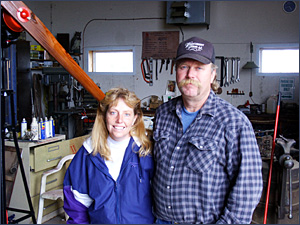|
Preventing a Climate Catastrophe
by John Rudolph
part 1 2 3 4 5
 | Windmills in Buffalo Ridge, Minnesota |  |
wind farmers Jane and Steve Tiedeman in Woodstock, MN. - photos by John Rudolph |
Minnesota Windmills
In a windy corner of Minnesota known as Buffalo Ridge, you can get an idea of the impact wind energy could have on reducing greenhouse gas emissions. More than 400 modern windmills have been built in this part of the state. The towering white structures look like huge dinosaurs looming over the landscape.
Steve and Jane Tiedeman farm 1,000 acres of soybeans and corn in Woodstock, Minnesota. Recently they installed two high-tech windmills that can generate enough electricity to serve about 500 homes.
Steve and Jane both grew up on farms - so agriculture is in their blood. And now, so is wind farming. They earn a third of their income from the sale of wind power.
"We get some real windy days, and people are cussing about it, and I can't say nothing."
Minnesota hopes to get 10 percent of its power from wind and other alternative sources by the middle of the next decade. But meeting that target is not likely to eliminate the need for new conventional power plants.
The pace of implementation of wind energy and other methods to reduce carbon dioxide emissions worries David Hawkins of the Natural Resources Defense Council.
"If we put a billion dollars today into a new coal-fired power plant that is designed with old fashioned technology, that power plant is going to be around for 50, 60, 70 years, and it's going to be putting carbon dioxide--global warming pollution--into the atmosphere for its entire lifetime. And the carbon dioxide is going to stay up in the atmosphere for hundreds of years. If instead we invest in a fleet of wind turbines, we will avoid that."
Some scientists argue that carbon dioxide in the atmosphere eventually needs to be reduced to levels that existed before the industrial revolution. In the future, hydrogen fuel cells could help reach this goal. So could building new nuclear power plants or a breakthrough in solar energy technology.
The answer will probably come from a variety of approaches. But the first step, according to Canadian climate researcher David Keith, is to reach a consensus on the threat posed by climate change, and what we are willing to spend to reduce that threat.
"The key question is are we willing, as a species, ultimately to spend a couple percent of global economic productivity over the next century to avoid making major climatic changes that lead to really quite substantial changes and extinctions and so on throughout the global environment? And I think when you put it to people in that terms, most people are willing to pay."
If we want to eventually halt human activities that cause harmful changes to the world's climate, we can do it.
Much of the technology exists, and new methods are being developed. What's harder is deciding if the risk is worth the effort and the cost. Is the threat of climate change, either gradual or abrupt - serious enough to take action on a global scale?
We know the world is getting warmer - that greenhouse gasses from human activities are being released into the atmosphere. But no one can predict with certainty the impact this warming will have on different regions of the world. Some places may get wetter, others could experience prolonged droughts. We also don't know if warming will lead to an abrupt shut down of ocean currents, and a dramatic cooling in some parts of the world.
Many believe the most important thing is to improve our methods for predicting climate change so we have a better idea of how severe future changes may be. But there is also a growing consensus among scientists that we must examine the imperfect information available to us now and use it to make some tough decisions. Preparing for abrupt climate change would be like taking out an insurance policy: start paying today to plan for the worst, and hope it never happens.
Back to Climate of Uncertainty
|

